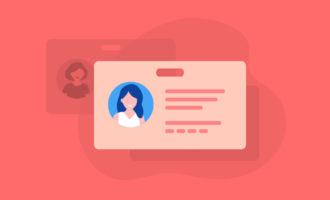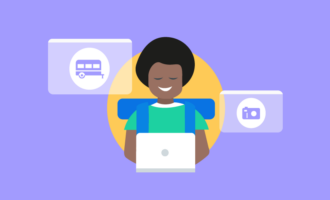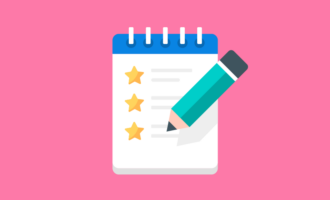Whether you are trying to start your own business or attempting to grow an existing one, your research has doubtless inundated you with industry jargon. Certain sales and marketing terms are everywhere, but no one ever seems to be able to fully explain what they mean. One hackneyed phrase you may have encountered is “sales funnel.” What exactly is a sales funnel, and how can it help you grow your business?
The funnel is a simple visualization of the sales process, with awareness of your brand at the top and closed sales at the bottom. There are a million different depictions of the funnel, each with their own labels and captions and bars and arrows and levels of granularity. But here is the one that will be used throughout this chapter and guide: Visitor > Lead > Qualified Lead > Opportunity > Customer.
The purpose of this guide is to help you direct new visitors into the funnel, turn them into leads and nurture them through the process until they become customers. Before you can jump into that involved process, though, here are in-depth definitions of each portion of the lead funnel.
Visitor
A person who visits any of your online properties, your website or your physical location is considered to be a “visitor.” This is someone who may not have known about your company previously and is still performing casual research. Ideally, information on your product or service is visible and engaging enough that their interest is piqued and they are enticed into the sales funnel.
According to the most recent PwC Global analysis of online shopping trends, for certain purchases, 62 percent of global shoppers prefer to research them online. This means that if your business is not engaging and catching the attention of each visitor from the outset, you are unlikely to retain them and convert them into a customer.
One way to accomplish your goal of making the visitor aware of your business is to have a well-designed website that clearly communicates the problem you solve, how you solve it and how they can get it. Eliminating noise and creating a clear message is the best way to ensure that visitors will want to continue to get to know more about your company. When they make that decision, they have just converted from a visitor into a lead.
Lead
A lead is someone who has opted in to receive information from your company, and/or to be contacted by your company in the future. A lead might be someone who filled out a form online or entered their contact information into a different type of gathering service.
Matthew Guay from Zapier said it best in The Marketing Funnel Guide: How to Qualify Leads and Turn Them Into Customers: “Random people on the street aren’t leads. They could become leads in the future—for now, though, they don’t know about your product. Leads, on the other hand, took action. They walked in, signed up, picked up the phone, asked.”
Leads are in the initial phase of the selling process, and needs to be nurtured in order to move further down the funnel. In this phase, the lead is someone who is interested in your product or service, but still has no definite purchasing intention.
Here, your job is to pique the lead’s interest enough that they are willing to take the next step: to develop a deeper interest and begin to engage with your product or service. To do so, you will provide them with information that will encourage them along the lead funnel process. At this point, you remain unclear as to whether or not the lead is actually willing or able to purchase from you.

Qualified lead
A qualified lead (or “prospect”) is someone who has demonstrated their ability and likelihood to purchase your product or service. There are several methods of qualifying leads. Some leads will qualify themselves by adding an item to their cart, for example; others may be qualified through asking specific questions in your sign-up form, such as income level or favorite brands; still others may be qualified using software that estimates the chances that an individual will make a purchase from you.
As you qualify leads, separate them into the “haves” (those who have demonstrated the ability and inclination to purchase your goods or services) and the “have nots” (those who do not have the ability or intention to purchase your product). The people who will actually purchase your product are those you will nurture, moving them along to the next step in the sales funnel. The others – or those who just want you to deliver them free, quality information forever without actually making a purchase – can be retained in an “email-only” passive candidate pool.
Qualification in this manner helps to keep you from spending money on leads who will never convert, and allows you to target your efforts on those with the highest chance of converting. Once you have a list of qualified leads, you will initiate two-way communication with them, reaching out to them individually and beginning the personalized communications that will lead to trust in your product or service. At this point, your objective is to move the people from leads to opportunities.
Opportunity
An opportunity is a person or business who is actively considering buying your product or service. Your beginning nurturing steps are integral in leading a consumer to this point. All opportunities must share three characteristics:
- They have a specific pain that you can solve for them. Without this, they will not purchase.
- They have a specific interest in your product or service. They might know their pain exists, but not be altogether interested in fixing it.
- They fit specifically with your company. Your product or service offering is developed for companies of their size or people with their budget.
Once you have identified a qualified lead as an opportunity, your goal is to find out what information the prospective opportunity needs or wants from you. Remember that this step – and every step (see Chapter 9) up until this point – are meant to do one thing: build a relationship. You need to provide the necessary information that they want or need in order to make their purchase from you. Most people make decisions based on emotions, and then back those decisions up with ration; your job is to develop that emotional relationship, then provide ample information to back it up.
Opportunities are the people you actively sell to. This will probably be the most demanding and critical stage of your funnel, and it might also be the longest stage of your sales funnel. At this point, you have verified the consumer’s need for and fit with your product or service. This is the time for you to close the deal, and to create a customer out of the opportunity.

Customer
This term should need little to no introduction. Customers are the people who have taken action, purchasing your product or service. You know they already like what you are offering enough to give you money. So that’s it, right? Not quite. Now, your job is to continue to engage with them and continue to nurture them.
Khalid Saleh, author and CEO of conversion software Invesp, explains that it costs five times as much to acquire a new customer as it does to retain a previous customer; so it is in your best interests to continue selling to customers long after their first purchase.
Once someone has reached this level in your lead generation funnel, you want to encourage them to take action again by selling the same product to them; to expand their initial purchase by upselling additional products or services to them; and to refer you and your product or service to everyone they know. One easy, automatic way to encourage a customer to take action again is to integrate different apps or services into your existing forms (see our growing catalog of options for ideas). Since these are consumers who have already indicated interest in your product and purchased it, you can leverage that sense of trust and dependability to offer more of your goods and services.
One the most important – and often overlooked – parts of nurturing customers is referrals. A recent Nielsen survey showed that 90 percent of internet-using consumers trust recommendations from people they know, and that people are four times more likely to buy a product when referred by a friend. What should you do with this information?
Engage your customer and solicit a referral. You have already won their trust and have qualified them as someone who can and wants to purchase your product or service. Now, you can skip a few steps in the sales funnel and have your customer bring new qualified leads to you – pre-vetted people who already have an interest in your product and are willing and able to buy. They have an emotional connection to you – their friend just vouched for your product – and you have a lead that can move towards the final “customer” phase more quickly and with a lower investment.
Conclusion
The rest of this guide is designed to help you learn how to get visitors to your site, convert them into leads, nurture them and measure your lead generation and conversion efforts. By the end, you will have a new, versatile tool in your toolkit that will help you develop a relationship with your leads, turn them into customers, and grow your business.






































































Send Comment:
1 Comments:
More than a year ago
Chad - I am in the real estate industry and real estate agents gets LOTS of leads. Managing the time to find the best leads that actually turn into a paycheck is a very difficult task. Great article with some very good points. Thanks for taking the time to write this up. Jim